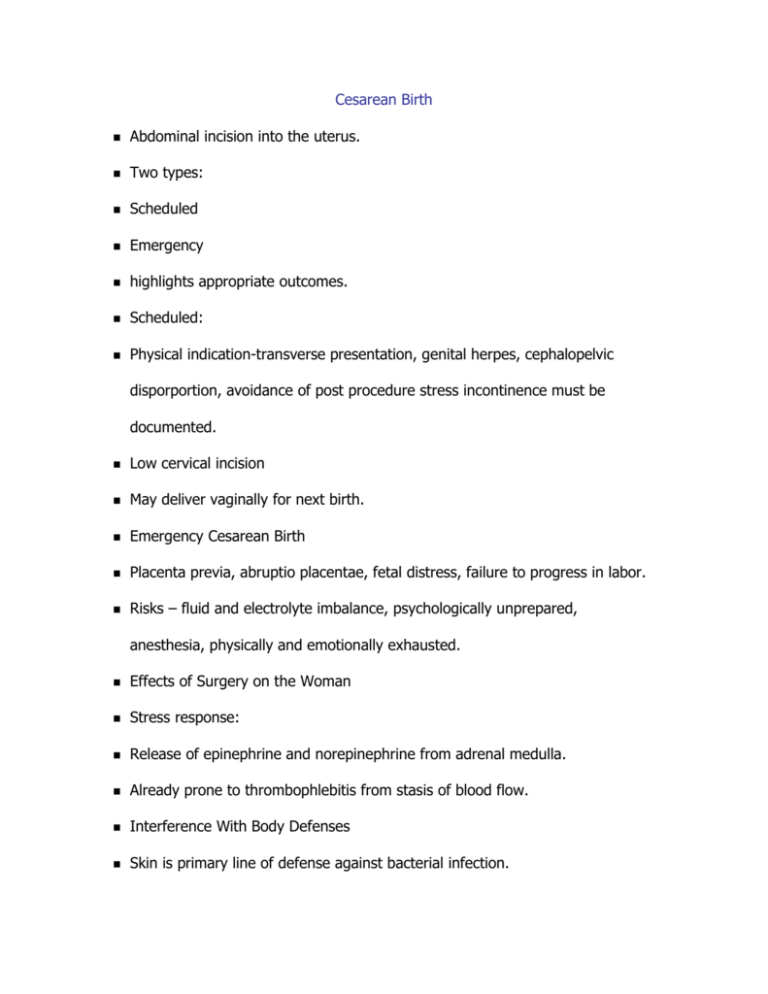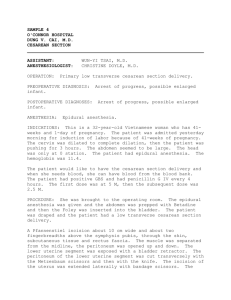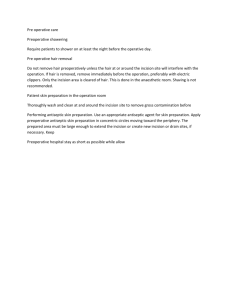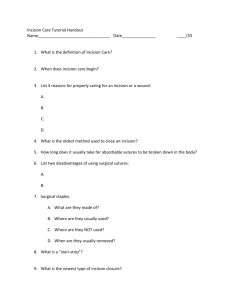Nursing Care of the Woman Anticipating a Cesarean Birth
advertisement

Cesarean Birth Abdominal incision into the uterus. Two types: Scheduled Emergency highlights appropriate outcomes. Scheduled: Physical indication-transverse presentation, genital herpes, cephalopelvic disporportion, avoidance of post procedure stress incontinence must be documented. Low cervical incision May deliver vaginally for next birth. Emergency Cesarean Birth Placenta previa, abruptio placentae, fetal distress, failure to progress in labor. Risks – fluid and electrolyte imbalance, psychologically unprepared, anesthesia, physically and emotionally exhausted. Effects of Surgery on the Woman Stress response: Release of epinephrine and norepinephrine from adrenal medulla. Already prone to thrombophlebitis from stasis of blood flow. Interference With Body Defenses Skin is primary line of defense against bacterial infection. Prophylactic antibiotic (Ampicillin) to protect against post surgical endometritis. Interference With Circulatory Function Blood loss- 500 to 1000 mL Interference With Body Organ Function Uterus may not contract as well and may lead to hemorrhage. Bladder may not sense filling as well Paralytic ileus or halting intestinal function. Interference With Self-Image or Self-Esteem Incisional scar, or may not deliver vaginally. Nursing Care of the Woman Anticipating a Cesarean Birth May be more worried because she had more time to worry, allow her time to talk about her fears. Include the support person. Preoperative Interview Anesthesiologist interview Nursing assessment Past surgeries, secondary illnesses, allergies, and current medications. Woman’s knowledge about the procedure Length of hospitalization anticipated Any postsurgical equipment to be used Operative Risk for the Woman 25% experience some complication Poor-Nutritional Status Obese-interferes with healing, risk for infection and dehiscence, increased workload on heart, more difficulty turning and ambulating, resp and circ complications Protein or vitamin deficiencies cause risk for healing. Age Variations Effects risk because of decreased circulatory and renal function. Adolescent or over 40 years are more at risk. Altered General Health Woman with a secondary illness is at risk depending on the extent of the disease. Cardiac disease, diabetes, anemia, kidney or liver disease. Current medications may interfere with anesthesia or healing of tissues. Fluid and Electrolyte Imbalance Lower blood volume will feel the effects of surgical blood loss. IV therapy may have been in labor and NPO for 24 hours. Fear Most are epidural anesthesia Let them acknowledge their fears. Operative Risk to the Newborn Greater risk Respiratory difficulty for 1 to 2 days. Transient tachypnea Pulmonary hypertension Preoperative Diagnostic Procedures Adequate circulatory and renal function must be documented. VS determination CBC PT, PTT Serum electrolytes and pH Blood typing and cross match Sonogram to determine fetal presentation and maturity. Preoperative Teaching Fear of the unknown Assess how much she already knows. Answer all questions. People under stress do not process new information well. Have them return the demonstration activities. Explain skin preparation, eating nothing before surgery, premedication, transport, IV, catheter, epidural catheter, early ambulation. Use visual aids Describe complications Teaching to Prevent Complications Gives the woman a positive outlook and sense of control over the situation. Deep breathing-5 to 10 deep breaths q 1 hour. Incentive spirometry Turning Ambulation – by 4 hours after surgery May wear TEDS Immediate Preoperative Care Measures Informed consent Nurse may witness, be sure they are informed Emancipated minors may sign for themselves Overall hygiene Shower, braid hair, clean gown, remove nail polish, contacts, jewelry, hair ornaments, acrylic fingernails may stay but toenails must be polish free. Gastrointestinal Tract Preparation Enema if ordered Reglan, Zantac or Bicitra may be ordered. Baseline Intake and Output Determination Indwelling cathether, if unable to insert it can be done at surgery time. Hydration IV LR size 18-20 gauge Nondominant hand so she can hold baby Preoperative Medication Minimum used Patients Chart and Presurgery Checklist Transport to Surgery In bed or stretcher in side lying position. Cover with a blanket Obtain chart, checklist and check ID Role of Support Person Encourage same participation Nursing Care May be relieved that surgery has been suggested. May feel disappointed. Obtain VS, UA, blood work, informed consent, elastic stockings, GI tract prep, catheter and IV. Little time for postoperative teaching. Intraoperative Care Measures Administration of Anesthesia Epidural usually administered while on side Assist the anesthesiologist Skin Preparation Shave abdominal hair Wash site Surgical Incision Towel under left hip Support person at head Types of Cesarean Incisions Depends on the presentation of the fetus and speed with which the procedure is performed. Classic-incision made vertically through abdominal skin and uterus. More risk to rupture in subsequent labors. Low segment incision is horizontal across the abdomen just over the symphysis pubis and across the uterus just over the cervix. This is the most common. Also called Pfannenstiel or bikini incision. Less likely to rupture. Less blood loss and easier to suture Birth of the Infant Retractors are slipped into the incision. Baby head delivered manually Baby is suctioned Oxytocin administered IV Membranes and placenta manually removed Tubal ligation at this time. Closing may take a long time and staples may be used on exterior skin. Introduction of the Newborn Once newborn is breathing spontaneously it is shown to parents. Assist mother to hold baby. Breastfeeding is delayed. Postpartal Care Measures Increased difficulty bonding Nursing Diagnosis Assess pain PCA for 1st 24 to 48 hours (morphine) Tylenol orally PRN TENS Intranasal Stadol or intrathecal morphine or pain controlled epidural anesthesia. Assess anxiety and fears Comfort measures- change positions or straighten linen. Check abdominal distention (gas pains) Place pillow over lap to deflect weight of the infant from suture line. No aspirin Epidural Analgesic Side effects-itching, nausea and vomiting. Monitor for hemorrhage 1st hour to 24 hours most risk. Monitor B/P, pulse, respiration q 15 minutes for 1st hour and every 30 minutes for 2 hour and every 1 hour for the next 4 hours. Falling B/P more than 20 mm Hg Changes in pulse over 110 bpm or below 60 bpm. Rapid respirations Restlessness and sense of thirst Inspect dressing and perineal pad and palpate fundus. Oxytocin may be added to 1st 1 to 2 L of fluid. Extended Postpartal Period May remain from 48 hours to 4 days depending on insurance. Adequate fluid intake. Keep I&O for 24 hr. Turn frequently and ambulate. Assess abdomen q8 hours for BS and flatus Start ice chips or sips of water 1 hour before removing IV. Advance to soft diet then regular diet. Record time of 1st BM Encourage diet high in roughage. May need a stool softener ordered. Catheter remains for 4 to 24 hours. 3000 to 5000 mL per 24 hours. After removed should void in 4 to 8 hours. Use methods to encourage voiding. Splint incision when moving. Leg exercises-flexing and extending knees. Thromboembolitic stockings. Check Homan’s sign Adequate rest. May shower Discharge Planning Follow up appointment in 2 weeks. Do not lift more than 10 lbs. for 2 weeks. Teach signs of infection. May resume coitus when comfortable. Give contraceptive information prior to D/C Inform they they may deliver next time vaginally.











